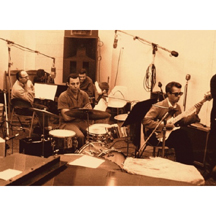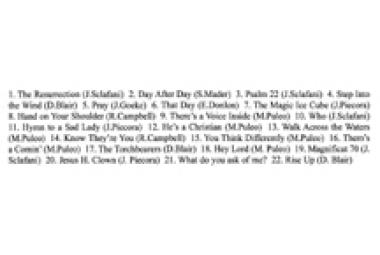Glen Campbell was part of a loose aggregation of dozens of session musicians who performed more or less anonymously on countless hit songs, primarily in the 1960's and 1970's. They came from a variety of backgrounds but were typically professionally trained musicians in jazz or classical music.
Drummer Hal Blaine dubbed the group the Wrecking Crew; Wikipedia says: "According to Blaine, the name 'The Wrecking Crew' was derived from the impression that he and the younger studio musicians made on the business's older generation, who felt that they were going to wreck the music industry." Wikipedia lists an almost completely different group of artists in that article (as opposed to those listed above who were backed by Glen Campbell in particular): "Notable artists employing the Wrecking Crew's talents included Nancy Sinatra, Bobby Vee, the Partridge Family, the Mamas and the Papas, the Carpenters, the 5th Dimension, John Denver, the Beach Boys, Simon and Garfunkel, the Grass Roots, and Nat King Cole."
The statistics about the Wrecking Crew are staggering, with various members appearing on tens of thousands of recordings. Hal Blaine is believed to be the most recorded drummer in history, while Tommy Tedesco is said to be the most recorded guitarist. From Wikipedia: "Blaine is credited with having played on at least forty U.S. #1 hits and more than 150 Top Ten records." And their talents were not limited to records; again from Wikipedia: "Tedesco's credits include the iconic brand-burning accompaniment theme from television's Bonanza, The Twilight Zone, Vic Mizzy's iconic theme from Green Acres, M*A*S*H, Batman, and Elvis Presley's '68 Comeback Special."
Hal Blaine and another drummer Earl Palmer were the first Sidemen inductees in the Rock and Roll Hall of Fame in 2000; the entire Wrecking Crew was inducted into the Musicians Hall of Fame in 2007. Wrecking Crew musicians formed the house band for the early concert film, The T.A.M.I. Show (1964); Glen Campbell can be seen in a few shots.
* * *
Superstar record producer Phil Spector used members of the Wrecking Crew to create his famed "Wall of Sound"; while Beach Boys bandleader Brian Wilson used these musicians on their acclaimed Pet Sounds album and their Number One hit "Good Vibrations".
* * *
One of the first successful female session musicians is bass guitarist and guitarist Carol Kaye; she preferred the name "the Clique" to the Wrecking Crew, and she is credited with appearing on 10,000 recordings. Kaye once commented that at her peak, she was earning more money than the President. Wikipedia reports: "Her intense solo bass line, reverberating in quiet moments in [Phil] Spector's production of [Ike and Tina Turner's] 'River Deep, Mountain High', lent drama to the song's 'Wall of Sound' and helped lift the record into the Grammy Hall of Fame." Her work for Quincy Jones so impressed him that, in his 2001 autobiography Q, he wrote (as quoted in Wikipedia): ". . . women like . . . Fender bass player Carol Kaye . . . could do anything and leave men in the dust."
Besides Glen Campbell, several members of the Wrecking Crew went on to great prominence in the music world, among them Mac Rebennack (better known as Dr. John) and Leon Russell. This time the Wikipedia quote is from one of my own contributions: "Also, Nino Tempo with his sister Carol (under her stage name April Stevens) had a U.S. #1 hit song in 1963, 'Deep Purple'." The song was originally a big-band hit in the 1930's and a top seller in sheet music back when this was a more important component of the music industry; the music was written by pianist Peter DeRose in 1933, with lyrics added five years later by Mitchell Parish. The name of the British rock band Deep Purple was suggested by guitarist Ritchie Blackmore because "Deep Purple" was his grandmother's favorite song; she used to play the song for him frequently on the piano.
(February 2015)















